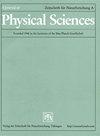Polar-plane flow in porous annular ducts with accelerated rotating walls. A region of stagnation inside the fluid
IF 1.3
4区 物理与天体物理
Q4 CHEMISTRY, PHYSICAL
Zeitschrift Fur Naturforschung Section A-A Journal of Physical Sciences
Pub Date : 2023-11-10
DOI:10.1515/zna-2023-0197
引用次数: 0
Abstract
Abstract The steady laminar flow of an incompressible Newtonian fluid in a porous annular duct with accelerated rotating walls is investigated. The flow is located in the polar plane and is driven by suction and injection at the walls. As required by conservation of mass with zero axial velocity, the fluid is injected into one of the cylinders, which becomes the upstream cylinder, and suctioned into the other, which represents the downstream cylinder. Only the case of the downstream cylinder at rest is examined. The duct gap ratio, the velocity ratio comparing the radial and azimuthal velocities, the Reynolds number, and the velocity coefficient that compares the fluid velocity at the upstream and downstream cylinders are the four parameters of the problem. The purpose of this research is to identify the prerequisites for the flow’s existence and determine how the aforementioned variables affect the flow velocity and pressure gradients at a fixed Reynolds number. The Navier–Stokes equations are replaced by the polar-plane vorticity equation, which is solved using the similarity-solutions method. The shooting technique, including the fourth-order Runge–Kutta algorithm, is used to produce numerical solutions. From the findings, physical understandings of the flow are derived. More specifically, we discover an unexpected interior zone where the fluid is perpetually at rest even while flow is present. The only solution found corresponds to the case of the inner cylinder upstream and rotating provided that the velocity ratio does not exceed the threshold of 0.1 with a velocity coefficient greater than 1.具有加速旋转壁面的多孔环形管道中的极平面流动。流体内部的停滞区域
摘要研究了不可压缩牛顿流体在具有加速旋转壁面的多孔环形管道中的定常层流。流动位于极面,由壁面的吸入和喷射驱动。根据轴向速度为零时质量守恒的要求,流体被注入其中一个圆柱体,即上游圆柱体,被吸入另一个圆柱体,即下游圆柱体。只检查下游气缸处于静止状态的情况。管道间隙比、径向速度与方位角速度之比、雷诺数、流体在上下游圆柱体处速度之比是问题的四个参数。本研究的目的是确定流动存在的先决条件,并确定在固定雷诺数下,上述变量如何影响流速和压力梯度。用极平面涡度方程代替了Navier-Stokes方程,用相似解法求解。采用射击技术,包括四阶龙格-库塔算法,生成数值解。根据这些发现,推导出了对流体的物理理解。更具体地说,我们发现了一个意想不到的内部区域,在那里,即使存在流动,流体也永远处于静止状态。找到的唯一解对应于内柱上游旋转的情况,前提是速度比不超过0.1的阈值,速度系数大于1。
本文章由计算机程序翻译,如有差异,请以英文原文为准。
求助全文
约1分钟内获得全文
求助全文
来源期刊
CiteScore
3.00
自引率
5.60%
发文量
81
审稿时长
3.3 months
期刊介绍:
A Journal of Physical Sciences: Zeitschrift für Naturforschung A (ZNA) is an international scientific journal which publishes original research papers from all areas of experimental and theoretical physics. Authors are encouraged to pay particular attention to a clear exposition of their respective subject, addressing a wide readership. In accordance with the name of our journal, which means “Journal for Natural Sciences”, manuscripts submitted to ZNA should have a tangible connection to actual physical phenomena. In particular, we welcome experiment-oriented contributions.

 求助内容:
求助内容: 应助结果提醒方式:
应助结果提醒方式:


